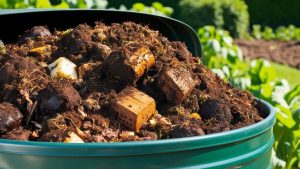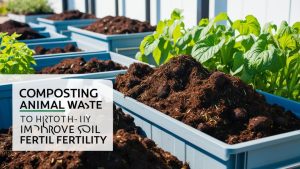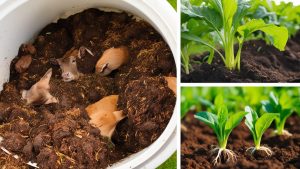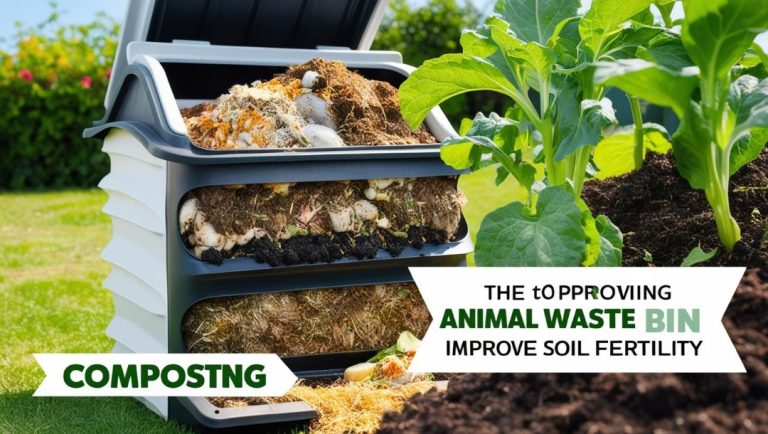Composting animal waste is an effective and sustainable method of managing livestock and poultry waste while improving soil fertility. Animal waste, including manure, bedding materials, and other organic residues, contains essential nutrients that enhance soil structure, microbial activity, and overall crop productivity. Proper composting transforms raw animal waste into a stable, nutrient-rich organic amendment that can be safely applied to soil without the risks of odor, pathogens, or environmental pollution.
This article explores the significance of composting animal waste, the processes involved, and best practices for achieving high-quality compost for agricultural use.
Click HERE to join our WhatsApp group chat
Importance of Composting Animal Waste
a) Enhancing Soil Fertility
Compost contains essential nutrients like nitrogen (N), phosphorus (P), and potassium (K), which improve soil fertility.
The gradual release of nutrients ensures long-term soil productivity and reduces dependency on chemical fertilizers.
b) Improving Soil Structure
Enhances soil aeration and water retention, reducing soil erosion and compaction.
Increases organic matter, promoting beneficial microbial activity and earthworm populations.
c) Reducing Waste and Pollution
Minimizes runoff of nutrients into water bodies, preventing water pollution and eutrophication.
Reduces methane emissions from raw manure, lowering greenhouse gas emissions.
d) Pathogen Reduction
The heat generated during composting kills harmful bacteria, parasites, and weed seeds.
Reduces risks of spreading diseases in livestock and humans.
e) Cost-Effective and Sustainable Farming
Composting reduces the need for synthetic fertilizers, saving farmers money.
Encourages environmentally friendly and organic farming practices.
READ ALSO: Climate Change and Its Impact on Livestock and Poultry
Types of Animal Waste Suitable for Composting

a) Manure
Includes cow, pig, sheep, goat, horse, rabbit, poultry, and other livestock droppings.
High in nutrients but requires proper balancing with carbon-rich materials.
b) Bedding Materials
Straw, sawdust, wood shavings, rice husks, and other absorbent materials used in animal housing.
Provides carbon to balance nitrogen-rich manure in composting.
c) Feed Residues and Food Waste
Uneaten feed, vegetable scraps, and expired animal feed can be composted.
Helps reduce waste and adds valuable nutrients.
d) Animal By-Products (Limited Use)
Feathers, hair, blood, and bones can be composted but require high temperatures for complete breakdown.
May need additional processing for safe composting.
The Composting Process

a) Key Components of Composting
Carbon-to-Nitrogen (C:N) Ratio
A balanced ratio of carbon-rich (bedding, straw) and nitrogen-rich (manure) materials ensures proper decomposition.
Ideal C:N ratio is 25-30:1.
Moisture Content:
Optimal moisture level is 50-60% to support microbial activity.
Too dry slows down decomposition; too wet causes odor and anaerobic conditions.
Aeration and Oxygen Supply:
Oxygen is essential for aerobic decomposition.
Turning the compost pile regularly enhances aeration and speeds up the process.
READ ALSO: Fattening Strategies for Beef Production
Temperature Control
Compost piles should maintain 55-65°C (131-149°F) for effective pathogen and weed seed destruction.
Proper insulation and pile management maintain optimal heat levels.
Time and Maturity
Composting takes 3-6 months for full decomposition, depending on management.
Fully composted material should be dark, crumbly, and have an earthy smell.
b) Methods of Composting
1. Windrow Composting
Compost is piled in long rows (windrows) and turned periodically for aeration.
Suitable for large-scale livestock farms.
2. Static Pile Composting
Piles are built and left to decompose without turning but require aeration pipes or forced-air systems.
Works well for farms with limited labor and equipment.
3. In-Vessel Composting
Uses enclosed containers or reactors to control temperature, moisture, and aeration.
Ideal for small farms or areas with limited space.
4. Vermicomposting
Uses earthworms to break down organic waste into nutrient-rich worm castings.
Best for small-scale composting of manure and kitchen scraps.
Best Practices for Composting Animal Waste

a) Site Selection
Choose a well-drained area away from water sources to prevent contamination.
Maintain distance from animal housing to reduce odor issues.
b) Proper Mixing of Materials
Layer manure with carbon-rich materials like straw, sawdust, or leaves.
Avoid excessive fresh manure to prevent ammonia buildup.
c) Regular Turning and Monitoring
Turn compost every 1-2 weeks for aeration.
Use a compost thermometer to track internal temperatures.
d) Covering the Compost Pile
Use tarps or straw covers to regulate moisture and temperature.
Prevents nutrient leaching during heavy rains.
e) Avoiding Contaminants
Do not include plastics, treated wood, or synthetic chemicals in compost.
Avoid composting diseased animal carcasses unless using high-temperature methods.
READ ALSO: Strategies to Ensure Adequate Water Supply for Livestock and Poultry
Application of Compost for Soil Fertility
a) Nutrient Enhancement
Compost enriches soil with essential macro and micronutrients.
Increases organic matter, reducing soil degradation.
b) Soil Moisture Retention
Improves water-holding capacity, reducing irrigation needs.
Enhances drought resistance in crops.
c) Disease Suppression
Beneficial microbes in compost protect plants from soil-borne diseases.
Reduces dependency on chemical pesticides.
d) Application Methods
Broadcasting: Spreading compost evenly over fields.
Incorporation: Mixing compost into soil before planting.
Mulching: Applying compost as a protective layer around crops.
Economic and Environmental Benefits of Composting
a) Cost Savings for Farmers
Reduces expenses on synthetic fertilizers and soil amendments.
Lowers waste disposal costs.
b) Sustainability and Climate Change Mitigation
Reduces methane emissions from raw manure storage.
Enhances carbon sequestration in soil.
READ ALSO: Vaccination and Disease Prevention Strategies
c) Improved Soil Productivity and Crop Yields
Increases long-term soil health and fertility.
Promotes sustainable agriculture and organic food production.
d) Compliance with Environmental Regulations
Helps farmers meet waste management and pollution control standards.
Reduces the risk of water and soil contamination.
Conclusion
Composting animal waste is an efficient and eco-friendly approach to improving soil fertility while managing livestock and poultry waste sustainably. By following best composting practices, farmers can transform manure and organic residues into high-quality soil amendments that enhance crop productivity, reduce environmental pollution, and promote sustainable farming. As global agriculture moves towards greener solutions, composting remains an essential tool for maintaining soil health and reducing dependency on synthetic inputs.
READ ALSO: Feed Ingredients and Their Nutritional Value
Proper nutrition is the foundation of healthy and productive livestock and poultry. Feed ingredients must provide essential nutrients, including energy, protein, vitamins, and minerals. Understanding the nutritional value of feed ingredients helps farmers formulate cost-effective and balanced diets…
READ ALSO: Feed Processing and Preservation Techniques
Feed processing and preservation are essential for maintaining nutritional quality, preventing spoilage, and enhancing digestibility in livestock and poultry diets. Proper processing ensures efficient feed utilization, reduces wastage, and improves animal performance…
Click HERE to join our WhatsApp group chat

